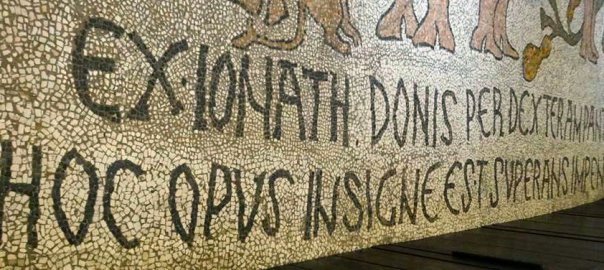

Introduction to EPIDOC
Tiziana Mancinelli
CCeH (Cologne Centre for eHumanities)
Università di Venezia

Philology is encoding
Aims of today's meeting
Encoding is an act of interpretation
TEI (Text Encoding Initiative
Epidoc: Epigraphic documents in TEI-XML

Text
Informatica Umanistica - Digital humanities

Electronic Publication

-
What does encoding texts allow you to do?
-
Publish electronically
-
Capture semantic distinctions
-
Single input, multiple outputs
-
Interchange materials with other projects
-
Federated search
-
Linked data
-
-
Reuse by self and others for different purposes
-
Long-term sustainability
-
Electronic Publication

-
Gives you larger audience
-
Frees you from restrictions of paper
-
Scale
-
Media
-
Hypertext
-
-
Speeds up re-release/update process
-
Changes the way you work
- Moves cost to different parts of process

-
EAGLE/Ancient World Mapping Center
-
Aphrodisias and Vindolanda
-
Integrating Digital Papyrology
-
EAGLE Europeana Network
- The Future

-
1999 Silvio Panciera, AIEGL Commission for Epigraphy and Information Technology:
-
- È importante che siano utilizzati programmi che consentano l'esportazione dei documenti in “Document Type Definition (DTD) format”
EAGLE

-
2000 Tom Elliott, Hugh Cayless, Amy Hawkins, Ancient World Mapping Center (UNC-CH)
-
-
EpiDoc Guidelines, version 1
-
AWMC - Ancient world mapping center

History of EpiDoc: prior art

-
EpiDoc recommended use of TEI
-
SGML/XML for literary/linguistic corpora since 1988
-
-
Based on Leiden distinctions (1931)
-
EAGLE / Krummrey-Panciera 1980/Panciera 1991
-
-
EAGLE fields
-
EDR / EDH / PETRAE etc.
-
-
Expanded for neighbouring disciplines
-
Papyrology
-
Other ancient inscribed objects (seals, coins…)
-
Other scripts (Mycenaean, Cuneiform, Mayan…)
-
Mondo visibile (Pagine we,
blog, wiki, social network)
Mondo materiale
(Libri, archivi, biblioteche, epigrafi,etc)
Mondo invisibile
(software, linguaggi, codifiche)
Da Fiormonte, Numerico, Tomasi,
"L'umanista digitale"

-
Convert datasets to EpiDoc
-
Including extensible/reversible tools
-
-
-
Delivery, search and browse platform (PN)
-
Son of Suda Online (SoSOL)
-
-
Workflow and editorial management tool
-
“Tagless” editing interface (“Leiden+”)
-
-
-
Documentation for users and developers
-
Dissemination and training, evangelism

Philology is Encoding
-
What you need to know:
-
Basic XML
-
TEI and EpiDoc distinctions
-
Which are based on your disciplinary needs
-
-
How to read guidelines/documentation
- Engage with community/ask for help
-
Text
EPIDOC - TEI (Text Encoding Initiative)
Che cos'è la TEI? www.tei-c.org
- Markup è utilizzato per molti scopi e in campi differenti.
- Permette di creare risorse e rappresentare la conoscenza
- Ha il compito di rendere esplicito (alla macchina) cosa è implicito a una persona ( disambiguazione)
- Facilita il riuso dei materiali:
- in differenti formati
- in contesti differenti
EPIDOC - TEI (Text Encoding Initiative)
Che cos'è la TEI?
- Nominare, annotare, descrivere dei dati
- attraverso un linguaggio formale
- per poter riusare quei dati in forme diverse
- e condividere i nostri progetti con altre risorse
EPIDOC - TEI (Text Encoding Initiative)
XML (EXtensible Markup Language) ?
Esiste un (e uno solo) elemento, detto elemento radice (corrispondente al nodo radice dell’albero), che non è contenuto da nessun altro e che contiene direttamente o indirettamente tutti gli altri
Ogni elemento, escluso l’elemento radice, deve essere contenuto da un solo elemento (elemento padre) e può contenere altri sotto-elementi (elementi figli) e/o stringhe di caratteri
Esiste un sottoinsieme di elementi che non contengono altri elementi e che possono
- essere vuoti
- contenere esclusivamente stringhe di caratteri

XML / TEI - Aspetti importanti
XML /TEI
Output
Pagine HTML
Epub
Linguaggi di trasformazione
Le tecnologie digitali e l’epigrafia
EpiDoc (Epigraphic Documents in TEI)
Formazione di una “EpiDoc community” per la creazione di standard e strumenti flessibili ma rigorosi per la codifica e lo scambio di testi epigrafici e papirologici
Iniziativa di Tom Elliott in risposta a un “manifesto” promulgato da Silvio Panciera e colleghi epigrafisti creazione di un database online liberamente accessibile di tutti i testi epigrafici greci e latini prodotti sino alla tarda antichità
Le tecnologie digitali e l’epigrafia
EpiDoc (Epigraphic Documents in TEI)
“Manifesto” della AIEGL - Aquileia e Trieste 2003
Tavola rotonda su “Épigraphie et Informatique” banca dati = federazione di più banche dati sotto un unico portale = EAGLE (Electronic Archive of Greek and Latin Epigraphy) http://www.eagle-eagle.it
Le tecnologie digitali e l’epigrafia
EpiDoc (Epigraphic Documents in TEI)
EpiDoc è un subset della TEI tags con una s[pecifica struttura:
<teiHeader> Frontespizio digitale
<text> diviso in
<facsimile> le immagini del documento
<body> dove convenzionalmente ci sono: edition, apparatus, bibliography, commentary, translation
Un esempio dal testo che state studiando. Prima parte
<?xml version="1.0" encoding="UTF-8"?>
<?xml-model href="http://www.stoa.org/epidoc/schema/latest/tei-epidoc.rng" schematypens="http://relaxng.org/ns/structure/1.0"?>
<?xml-model href="http://www.stoa.org/epidoc/schema/latest/tei-epidoc.rng" schematypens="http://purl.oclc.org/dsdl/schematron"?>
<TEI xmlns="http://www.tei-c.org/ns/1.0" xml:space="preserve" xml:lang="en">
<teiHeader>
<fileDesc>
<titleStmt>
<title>Testo 1. Calvelli 2015</title>
</titleStmt>
<publicationStmt>
<authority>AA</authority>
<idno type="filename">12</idno>
</publicationStmt>
<sourceDesc>
<msDesc>
<msIdentifier>
<repository>museum/archive</repository>
<idno>inventory number</idno>
</msIdentifier>
<physDesc>
<objectDesc>
<supportDesc>
<support>description of object/monument (likely to include <material/>
and <objectType/> information, <dimensions/>, etc.)</support>
</supportDesc>
<layoutDesc>
<layout>description of text field/campus</layout>
</layoutDesc>
</objectDesc>
<handDesc>
<handNote>description of letters, possibly including <height>letter-heights</height>
</handNote>
</handDesc>
</physDesc>
<history>
<origin>
<origPlace>Place of origin</origPlace>
<origDate>Date of origin</origDate>
</origin>
<provenance type="found"> Findspot and circumstances/context
</provenance>
<provenance type="observed">Modern location(s) (if different from repository, above)
</provenance>
</history>
</msDesc>
</sourceDesc>
</fileDesc>
</teiHeader>
<facsimile>
<graphic url="facsimile.jpg"/>
</facsimile>
Un esempio dal testo che state studiando. Prima seconda
<text>
<body>
<div type="edition" xml:space="preserve">
<ab>
<lb n="1"/>Cusonia
<lb n="2"/><expan><abbr>M</abbr><ex>arci</ex></expan> <expan><abbr>f</abbr><ex>lia</ex></expan> Posilla
<lb n="3"/>viva sibi fecit eṭ
<lb n="4"/>Passenae Osti <expan><abbr>f</abbr><ex>iliae</ex></expan>
<lb n="5"/>Enocliae matrì,
<lb n="6"/>Cusoniae <g type="mulieris"/> <expan><abbr>l</abbr><ex>ibertae</ex></expan>.
</ab>
</div>
<div type="apparatus">
<lb/>
</div>
<div type="translation">
<p>translation(s)</p>
</div>
<div type="commentary">
<p>commentary</p>
</div>
<div type="bibliography">
<p>bibliography of previous editions, discussion, etc.</p>
</div>
</body>
</text>
</TEI>

Per qualsiasi chiarimento:
tiziana.mancinelli@unive.it
tiziana.mancinelli@uni-koeln.de
Grazie per la partecipazione. Buono studio!
Epidoc
By tiziana_m
Epidoc
- 1,130



